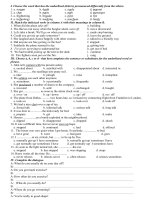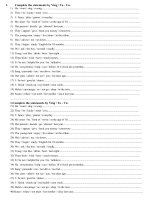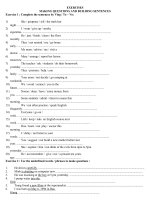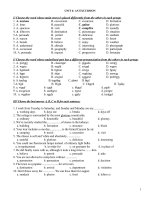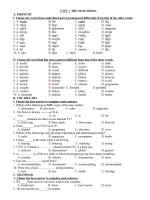unit 16 english 10
Bạn đang xem bản rút gọn của tài liệu. Xem và tải ngay bản đầy đủ của tài liệu tại đây (2.36 MB, 23 trang )
<span class='text_page_counter'>(1)</span><div class='page_container' data-page=1></div>
<span class='text_page_counter'>(2)</span><div class='page_container' data-page=2>
Part A: Reading
<b>Unit 16 </b>
</div>
<span class='text_page_counter'>(3)</span><div class='page_container' data-page=3></div>
<span class='text_page_counter'>(4)</span><div class='page_container' data-page=4></div>
<span class='text_page_counter'>(5)</span><div class='page_container' data-page=5></div>
<span class='text_page_counter'>(6)</span><div class='page_container' data-page=6></div>
<span class='text_page_counter'>(7)</span><div class='page_container' data-page=7>
Unit 16: Historical places
Van Mieu- Quoc Tu Giam is a famous historical and
cultural site in Hnoi. Originally built in 1070 in the Ly
dynasty, Van Mieu was representative of Confucian ways
of thought and behaviour. Six years later, Quoc Tu Giam,
the first university of Vietnam, was established on the
grounds of Van Mieu. Between 1076 and 1779, Quoc Tu
Giam educated thousands of talented men for the country.
In 1482, Van Mieu became a place to memorialize the
most brilliant scholars of the nation. The names, places of
birth and achievements of top students in royal
examinations were engraved on stone stelae. These
stelae, carried on the backs of giant tortoises, are still
standing today and they attract great interest from visitors.
After more than 900 years of existence, Van Mieu is an
example of well-preserved traditional Vietnamese
architecture. The banyan trees in Van Mieu, which
</div>
<span class='text_page_counter'>(8)</span><div class='page_container' data-page=8></div>
<span class='text_page_counter'>(9)</span><div class='page_container' data-page=9></div>
<span class='text_page_counter'>(10)</span><div class='page_container' data-page=10>
I. Before you read
•
<sub>Vocabulary:</sub>
1. Stele
['sti:li]
(n) –
stelae
(pln):
2. Banyan tree
['bæniən tri:]
(n)
3. Originally
[ə'ridʒnəli]
(adv) = initially
[i'ni∫əli]
4. Representative
[,repri'zentətiv]
(adj)=
typical
['tipikl]
(adj)
5. Memorialize
(v):
[mə'mɔ:riəlaiz]
(v)
6. Engrave
[in'greiv]
(v)= carve
[kɑ:v]
(v)
7. Flourish
['flʌri∫]
(v):
</div>
<span class='text_page_counter'>(11)</span><div class='page_container' data-page=11>
II. While you read.
Task 1: Choose A, B, or C that best suits the meaning of the
italicised word.
1. Van Mieu was <i>originally</i> built in 1070 in the Ly dynasty.
A. beautifully B. initially C. finally
2. It is <i>representative</i> of Confucian ways of thought and
behavior.
A. typical B. fond C. traditional
3. Van Mieu was a place to <i>memorialize</i> the most brilliant
scholars of the nation.
A. ignore B. gather C. honor
4. The stone stelae were <i>engraved</i> with the names of the top
students in royal examinations
A. printed B. carved C. washed
</div>
<span class='text_page_counter'>(12)</span><div class='page_container' data-page=12>
<b>1</b>
<b><sub>2</sub></b>
<b>3</b>
<b>4</b>
<b><sub>5</sub></b>
<b>6</b>
<b>7</b>
</div>
<span class='text_page_counter'>(13)</span><div class='page_container' data-page=13>
1. The construction of Van Mieu took
place between 1076 and 1779.
<b>it was built in 1070.</b>
<b><sub>F</sub></b>
Van Mieu – Quoc Tu Giam is a famous historical
and cultural site in Hanoi. Originally
built in 1070
</div>
<span class='text_page_counter'>(14)</span><div class='page_container' data-page=14>
2. Quoc Tu Giam is considered to be the
first university of Viet Nam.
<b>T</b>
</div>
<span class='text_page_counter'>(15)</span><div class='page_container' data-page=15>
3.
Thousands of talented men were
trained in Quoc Tu Giam from the 11
thto the 19
thcentury.
<b>from 11</b>
<b>th </b><b>to the 18</b>
<b>th </b><b>century</b>
<b>F</b>
</div>
<span class='text_page_counter'>(16)</span><div class='page_container' data-page=16>
4. Van Mieu has now lost most of its
traditional Vietnames architecture.
It is an example of well-preserved
traditional Vietnamese architecture.
<b>F</b>
After more than 900 years of existences,
</div>
<span class='text_page_counter'>(17)</span><div class='page_container' data-page=17>
5. Festivals and examinations used to be
held in Van Mieu – Quoc Tu Giam.
<b>T</b>
The banyan trees in Van Mieu , which
</div>
<span class='text_page_counter'>(18)</span><div class='page_container' data-page=18>
The banyan trees
in Van Mieu , which
witnessed festivals and examinations
during
feudal times
, continue to flourish.
6. Visitors can still see some trees
which have been in Van Mieu for a
long time.
</div>
<span class='text_page_counter'>(19)</span><div class='page_container' data-page=19></div>
<span class='text_page_counter'>(20)</span><div class='page_container' data-page=20></div>
<span class='text_page_counter'>(21)</span><div class='page_container' data-page=21>
built in 1070 in …(2)…….
…(3).. ..many talented
men for the country
A place to …(4)...
the most brilliant scholars
of the nation
Top students were
engraved on …(5)…..
still…(6)………..
The …(7)...
witnessed festivals
and exams
<i><b>III. After you read</b></i>
<i><b>Complete the following chart:</b></i>
<b>Van Mieu- Quoc </b>
<b>Van Mieu- Quoc </b>
<b>Tu Giam</b>
<b>Tu Giam</b>
A site of …(8)………
A site of …(8)………
for Vietnamese people.
for Vietnamese people.
The ...(1)………
The ...(1)………
of Viet Nam
of Viet Nam <sub>stelae</sub><sub>stelae</sub>
well-preserved
well-preserved
first university
Ly dynasty
educated
</div>
<span class='text_page_counter'>(22)</span><div class='page_container' data-page=22>
<b>IV.HOMEWORK</b>
<b>1. Learn by heart the new words,</b>
<b>2. Complete the exercise in textbook.</b>
</div>
<span class='text_page_counter'>(23)</span><div class='page_container' data-page=23></div>
<!--links-->


